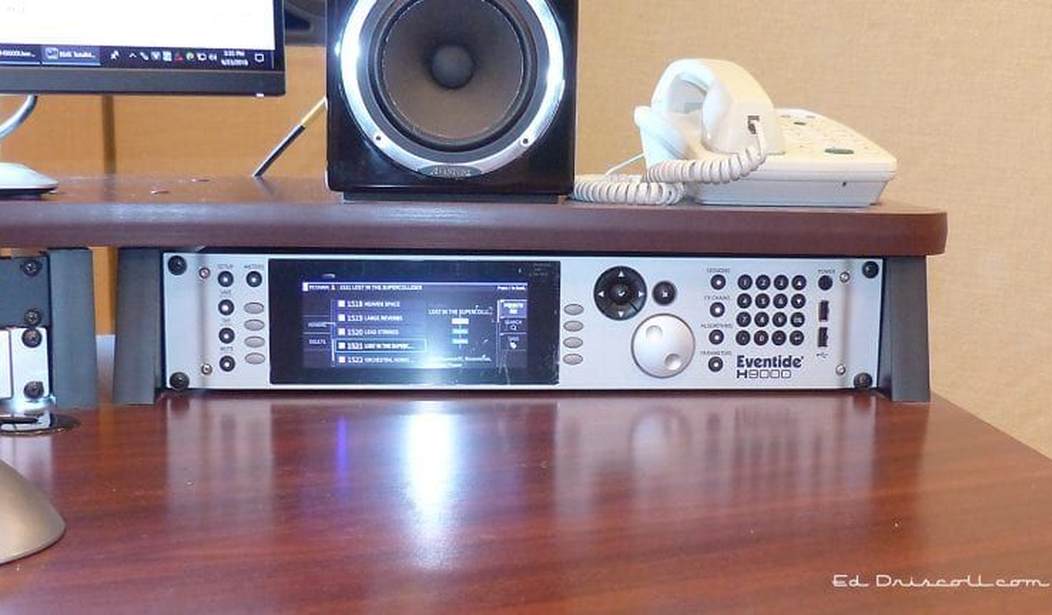Back in June of 2018, I published what was quite possibly the first review of the then-brand-new Eventide H9000 Harmonizer. At least, to my astonishment, it was the first review linked to Eventide’s Website. To this day, I’ve found that there’s a dearth of information and audio clips of the H9000 in action, so I’m writing this article for the person who is Googling around, thinking of acquiring an H9000, wanting to hear some audio clips, and looking to read about the unit in action. (Conversely, to paraphrase Austin Powers, if recording music isn’t your bag, baby, this article is likely to read as absolute gibberish.)
I knew going into my acquisition of the H9000 that it would be a work in progress, having replaced the H8000, which was introduced in 2005. Since my 2018 review, a number of updates have been made to the H9000. Perhaps the most important of those was that shortly after the H9000 initially shipped, Eventide added the first iteration of their Emote software, which allows for remote control of the rack-mounted H9000 via a PC or Mac, with Emote working as either a DAW plugin or as a standalone program. (The latter version is useful if Emote slows down your DAW’s graphics performance.)
Prior to the introduction of Emote, the H9000 required the use of its control panel to manipulate its algorithms and effects chains. For me at least, this meant a certain brute-force approach to the H9000, plastering effects on whatever track I sent through it.
The Emote initially didn’t allow for saving the algorithms and effects chains created or modified by the user, so during my first efforts of using the applet, I wrote copious track notes in Microsoft Word and copied and pasted screenshots of the Emote GUI so that I could rebuild a preset if I ever needed to revisit a song or use a favorite effect again. Eventually, by last year, Eventide added the ability for a user to save his own presets.
In addition to presets created for the H9000 and those ported from previous iterations of Eventide Harmonizers, the unit also contains all of the presets that were created for the H9, Eventide’s popular guitar multi-effects pedal. These over 1,500 algorithms can be grouped together with up to four algorithms into a custom FX Chain. While four is the maximum number of FX chains the H9000 offers as a default, there are three expansion card slots in the rear of the unit allowing for an additional I/O with up to 32 channels of bidirectional audio via each card, making the H9000 potentially a powerful centerpiece of a pro studio with multiple control rooms.
The H9000 is therefore an awesome tool for shaping vocals, guitars, and synthesizers. There are also a few bass guitar-oriented effects, but I eventually decided I’m not a big fan of time-based effects such as chorus on bass guitars. However, these may fit your needs perfectly. This song from 2018, “Indian Summer,” uses H9000 #1209 Bass Room FX Chain on the Fender Precision Bass. The organ on the song is an organ patch from a 2006 Roland VG-88 guitar modeling rig run through the H9000’s 9504 SpaceTime Algorithm through its Faux Leslie patch.
The Edge of Floyd
One of the first songs where I took a deeper dive into using the Emote app was a song I began in late 2019, eventually titled, “The Rain Falls Hardest at Night.” I had wanted to explore the rhythmically-timed digital delay guitar effects that David Gilmour prominently used on several song on Pink Floyd’s The Wall, and The Edge has made a career out of in U2. The guitar sound is a 1998 Fender Nashville Telecaster into a Radial J-48 Direct Injection box, powered by an old Rolls 48-volt power supply, necessary since, while the Eventide H9000 has XLR inputs and outputs, it lacks phantom power, which the Radial DI box needs.
The H9000’s outputs were patched using a stereo Y-cable into a then-new Strymon Iridium amp modeling pedal. Inside of the H9000, using Emote, I stacked together first the H9000’s CleanPreamp algorithm, into their Vintage Delay algorithm, using a tweaked version of a preset called “FoundIt,” obviously inspired by The Edge’s digital delay line on “I Still Haven’t Found What I Was Looking For.”
The two delays in the Vintage Delay pedal algorithm were set to a quarter note, and a dotted eighth-note delay, with 25% and 33% feedback respectively.
After completing this song in early 2020, even before the pandemic hit, I thought it would be fun learning more about what the H9000 was capable of. I had banked a number of songs I had written and recorded when I still lived in California, and used their multitrack files as fodder for adding effects and new sounds from the H9000, often replacing the lead vocals and guitar parts with the better microphones and gear I’ve since acquired. (And with better skills. I’m kicking myself for not recording clean DI guitar tracks back in the day simultaneously with the guitar parts that were recorded using now somewhat cheesy-sounding Roland guitar modeling rigs. Live and learn — the hard way.)
Updating Old Songs
By the fall of 2020, I went to work rebuilding a song I completed in 2015 called “The Mighty Ocean,” with lyrics inspired by some of the themes in Pete Townshend’s then-recent autobiography, Who I Am. The end result encapsulates many of the H9000 techniques I stumbled over throughout the year.
The original lead vocal was recorded in 2015 into my then-40-year-old Shure SM58 dynamic microphone.
I re-sang the vocal, this time around into Neumann’s reissue of their classic U67 tube condenser mic, into a Chandler Ltd. Redd.47 pre-amp, into a Universal 1176LN FET compressor into a Warm Audio WA-2A tube compressor. (Warm’s LA-2A clone would be replaced by the real thing the following year.) I replaced the bass guitar, originally recorded, if I remember correctly, using a Fender bass patch on the Roland VG-99 guitar modeling rig, with an actual 1983 Fender Precision Bass strung with Rotosound round-wound strings.
The guitar solo was rerecorded using a 2000 Gibson Historic R9 Les Paul into the Radial J-48 DI box, which was then sent into the H9000’s Crush Station fuzz effect, then their clone of Roland’s Dimension D spatial enhancement effect, which was then sent into Strymon Iridium with the H9000’s stereo XLR outputs into quarter inch plug adaptors, into a Y-splitter, to maintain the H9000’s stereo spread. The rhythm guitar parts were the tracks recorded in California in late 2014 or early 2015 on a Roland VG-88 guitar modeling rig but re-amped through the Iridium. Some of the guitar fills were also treated with the H900’s Dimension D patch.
During my 2020 recording blitz, I got in the habit of duplicating completed guitar solos and lead vocals, sending them into the H9000, and then chopping the tracks up as needed to isolate the last notes in a phrase, to create delay throws, sometimes using digital delay algorithms, and sometimes using reverb effects. The H9000 effects would then recorded as separate effects tracks in my DAW.
All I Need is the (Thick) Air That I Breathe
Speaking of sending guitar solos into the H9000 to add additional effects, there’s a preset in the H9000 that I’ve grown quite fond of called EMH Thick Air (with EMH short of Eventide Music Hall, I’ve always assumed). In the guitar solo, you can hear it creating fantasy reverb splashes. The digital delay effects in the solo were created using various modified versions of the H9000’s Ultratap algorithm.
As the track was nearing completion, an idea popped into my head: How would it work if a portion of the concluding main guitar riff is repeated, but processed through the EMH Thick Air effect? I simply duplicated a portion of the riff, pasted it into the DAW using the time grid to keep everything lined up, and then sent that portion into the EMH Thick Air preset. To my ears, it was a cool effect, building up tension near the end of the song, and varying a riff that by the end of the song, listeners have already heard several times.
To create a massive splash on the drum hit at the end of the song, I fed the hit (a Sony Acid loop of a kick drum hit and cymbal crash) into the H9000’s #1307 Basic Drum Chain, but with the SP2016 Reverb’s #26 preset, “Massive/Hand of God” with the mix on the FX chain at about 80 percent.
Manic Pixie Tom-Toms
Last month, I started rebuilding “Manic Pixie Dream Girl,” the last song I completed before I left California in 2016. I replaced the Roland VG-88’s modeled acoustic guitar with an actual Gibson acoustic which I then ran through the Dimension D algorithm with a mix of 74 percent the acoustic guitar and 36 percent the effects patch, just to wet the guitar up a bit. The VG-88 lead guitar with my 2000 R9 Les Paul into a Strymon Iridium, which was then processed through the H9000’s “TriCeraChorus” algorithm’s “Slow Swirl” patch to recreate the sound of an electric guitar through a rotating Leslie speaker. The lead synth sound was from the Korg M1 software synthesizer from 2015, which I ran through the H9000’s
The telephone voice effect on the lead vocal at about the 3:30 mark in the song was created by inserting the “Telephone Suite” algorithm into the #1122 “Flanger” chain. (It’s a reminder that the default effect chains can often be easily tweaked by adding a new algorithm, or swapping one of the default algorithms out with something new.)
The tom-tom hit at about the 2:55 mark (following the reference to a nervous breakdown) was a Sony Acid tom flam made more massive with the #5023 “Kickback” reverb splash algorithm which was then reversed in my DAW and slid in front of the tom hit. Then I ran the tom through the #4918 “Gravity Verb” algorithm for a large reverb sound after the drum hit. The tom-tom roll at about the 3:30 mark was processed through the “EMH Thick Air” chain, which you can really hear in the space between the last tom roll and the swelling cymbals that follow.
Finally, I reversed my obsession with adding delay throws and reverb splashes on lead guitar solos — this time adding them to the synth solos. There are various “Thick Air” and “Timeslips” splashes on the synth solos, and finally at about the 4:12 mark a wild delay throw is made by sending the synth through the #1527 “Ultra Crystals” chain.
The Blood Stays on the Supercollider
I was having fun rebuilding these old songs, but the master tracks of the first five years or so of recordings I made on a DAW starting in 2000 were lost due to a hard drive crash and poor backup habits. (I’ve since gotten much more religious about hard drive backups, needless to say!) I used the music remix applet in Izotope’s RX9 to split some of these early songs into separate drum, bass, vocals, and “everything else” tracks to form the basis of rebuilding these songs from scratch. I wrote a whole article on this process last year, so I won’t rehash the details, but I did want to mention a couple of songs where I used the H9000 in an interesting way.
“The Blood Stays on the Blade” was a 2003 song inspired by a critic’s review of the Martin Scorsese film, Gangs of New York, that used that line from the film in its lede. At the end of the song, I ran the final drum hit into a H9000 preset called “Lost in the Supercollider” for a dramatic rhythmic ending. The effect when I sing “make my stand” halfway through the song was the #1410 “Ambient Pads” effects chain with a #9106 “Band Delay” algorithm inserted into the chain, using its “Time Slips 1” preset with one delay set to whole notes and the other to half notes.
To bring things full circle, four years on, the H9000 remains a bit of a work in progress — there are still some presets from the H8000 that haven’t been ported over yet. And the Emote feels like it still needs some work. The ability to quickly A/B settings, something many “in the box” VST effects allow, would be very welcome.
The H9000’s long start-up time, about two minutes and nine seconds — yes, I timed it with my iPhone’s stopwatch — may be a bit frustrating for some. It encourages using the unit during a long day or evening of work, not a quick bit of “hey, let’s try this!” experimentation. On the other hand, there’s a lot going on under the hood, in what is effectively a powerful computer purpose-built for audio manipulation.










Join the conversation as a VIP Member